| 1 | Churchill, Manitoba |

A Canadian town of 900, where car doors are kept unlocked and all citizens walk around with two heavy rocks in their pocket. Why? Because Churchill, on the west coast of the ice-choked Hudson Bay, lies directly in the polar bear community’s annual migration route.
For six weeks in October and November every year, dozens of polar bears roam Churchill’s outskirts, as they impatiently wait for the sea ice to reform. Churchill has been dubbed “the polar bear capital of the world” and ranks first for tourism, with 10,000 polar bear hunters (with their eyes, not guns) visiting yearly.
Since 1982, only one person has been killed by a polar bear here, a homeless man who was rummaging in a dumpster only to feel a huge shadow descend on him. However, it’s perfectly common to pull back your curtains at 9am only to find a polar bear’s head staring back at you. Churchill residents have endless stories, including bears stuck in hospital doors, and miraculously scaring bears away with their cellphone light. Polar bears rummaging in bins and casually walking the streets are a common sight.
Churchill has become particularly infamous for its polar bear jail. The town’s first defence is guards who fire loud cracker shells, but the most nuisance bears are darted, tranquillised and held for thirty days before being drugged and airlifted by helicopter back onto the sea ice. The bears are also starved in the jail, to imprint the dangers of Churchill onto their brain.
Churchill is the most accessible polar bear viewing spot on Earth. Times have changed since the 1970s, when scientists would crouch on the tundra all night cradling shotguns; now you can ride the outskirts of Churchill in an iron-coloured, double decker, bus-sized tundra buggy.
However, it still feels like the polar bears own Churchill sometimes. Just remember that the town is only accessible by train and helicopters. Green coloured signs reading “POLAR BEAR ALERT. Stop! Don’t walk in this area” are dotted everywhere, with strangely innocent looking polar bear pictures.
| 2 | Wrangel Island, Russia |
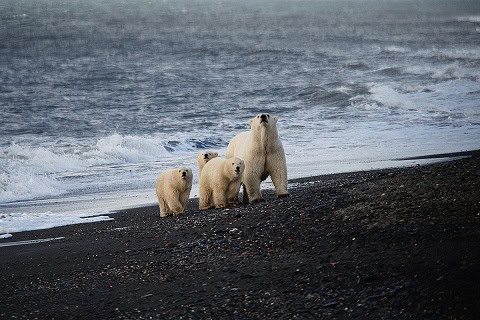
Possibly the last place on Earth where woolly mammoths survived, clinging on until 4500 years ago compared to 10000 on the Siberian mainland. Wrangel Island has a storied history too; when the US ship Karluk sank in 1914 and its survivors dispersed onto the sea ice, Wrangel Island is where five men headed for refuge (their starved bodies were discovered later).
Today though, the place is swarming with polar bears. In fact, this icy, mountainous island has the highest density of polar bear breeding dens of anywhere on Earth. Wrangel Island contains a big chunk of the Barents sea polar bear subpopulation, which numbers 2500 bears.
Originally, Wrangel Island had two weatherbeaten permanent settlements, but in 1972, the Soviet Union declared the island to be a nature reserve and relocated them. Since then, polar bear numbers have been climbing. 500-570 were spotted in 2017 compared to 200-300 in previous years. The polar bears are so confident that Russia’s scientific research stations have windows equipped with iron bars to prevent break-ins. The rangers have to carry pepper spray and flare guns at all times.
In 2017, a tourist ship was sailing the icy outskirts of Wrangel Island, when it spotted a dead bowhead whale on the shore. Soon, no less than 230 polar bears arrived to feast on its carcass. You’ll find polar bears relaxing on Wrangel Island from mid-August to November as they wait for the ice to reform, accompanied by 100,000 Pacific walruses and thousands of seals. The polar bear shares the inner island with only one land mammal, the Arctic fox.
5000 years ago, polar bears and woolly mammoths lived side by side on Wrangel Island. Today, it’s the bears who are in command.
| 3 | Arviat, Canada |
There was a time when Arviat was an isolated human settlement with a smattering of polar bears, but nowadays, Arviat is the opposite. Arviat is a small village of 2500 people in Manitoba region of Canada, with bowhead whales, seals, and arctic foxes galore. It’s part of the Hudson bay population, which numbered 840 in 2016, but locals insist that polar bears have boomed since 2000.
Nowadays, it’s perfectly normal in Arviat to witness a polar bear mother playing with her cubs on the distant ice. Hunting cabins are constantly fearful of bears poking their noses in. Trick or treat was once popular on Halloween in Arviat, and so was autumn berry picking, but unlike 50 years ago, you can now see white, fluffy bears walking the streets daily in autumn.
The invasion came to a head in 2010 and 2011, when 11 polar bears were shot dead in self defence. Since then, locals have invented solutions like relocating frozen meat into indoor steel containers indoors instead of simply storing meat on their roofs. There’s also an FM radio which is constantly being interrupted to announce new sightings, and a WWF-appointed guard called Leo who patrols the town with spotlights and bangers.
Miraculously, in the last 20 years, only one man has been killed, a hero who screamed his lungs out to distract a polar bear from mauling a girl in 2018.
The reason for this bear mania is identical to Churchill: its location on Hudson Bay’s west coast, causing polar bears to accumulate in October and November. Superstitious local hunters believe that if you shoot a polar bear’s head with a rifle but miss, the polar bear will give you a headache lasting for days. Arviat village elder Johnny Kartek once stated that “bears attack down the family line, like a curse”.
| 4 | Svalbard, Norway |
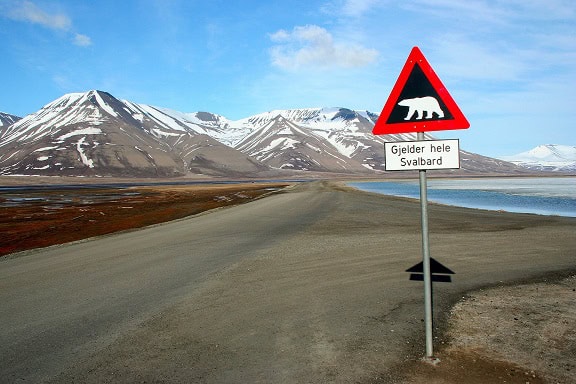
Svalbard is the northernmost settlement in Norway, and it’s obvious why – it’s the northernmost settlement the polar bears will allow. Svalbard is a collection of islands deep within the Arctic circle, and contains a big fraction of the Barents sea polar bear population.
The bears in Svalbard actually increased from 685 in 2004 to 975 in 2015. They aren’t starving, straggly bears either; these days, they’re supposedly “fat as pigs“. Hunting on Svalbard was once rampant, but in 1973, a law was passed protecting them. On Svalbard, you can only shoot a polar bear in strict self defence, and are forced to report to the governor afterwards.
Shootings of polar bears have thus plummeted in recent decades, allowing the bear population to keep on growing. Since 1971, only 5 people have been killed by bears. In 1971, 1977, and 1995, the victim wasn’t carrying a weapon, while in 1995 (a different attack), the victim was carrying a tiny pistol. Pictures of polar bears with their faces pressed against windows are a dime a dozen, but overall, this popular tourist destination coexists fairly peacefully.
Cruise ships are constantly sailing past, with people on deck desperately trying to get a glimpse of bears as they prowl the coastline searching for seals and dead whales. Along with Churchill, Svalbard is the most popular polar bear tourism destination in the world. Svalbard has dozens of islands, but the most polar bear packed region is King Karls Land, with twelve dens per square kilometre.
Svalbard has strict regulations. All cruise ships are required to have a special polar bear guard aboard. On land, it is mandatory to carry a gun outside of the population capital Longyearbyen. Shops in the township even have special deposit boxes for storing your gun.
| 5 | Kaktovik, Barter Island, Canada |
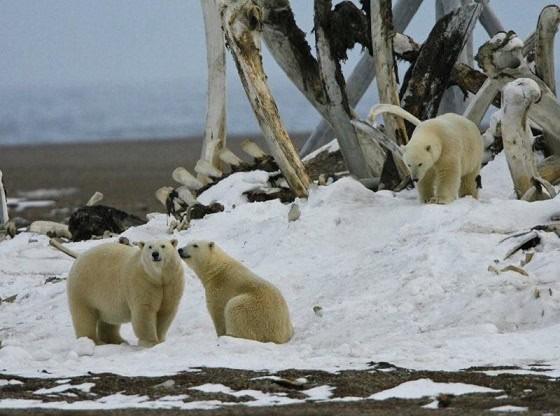
Barter Island is a frigid slab of ice located directly above Alaska’s north coast and Kaktovik is its biggest settlement, the northernmost permanently inhabited place in the USA and a former cold war missile defence outpost. Once, those inhabitants were mostly humans. Today, they’re mostly polar bears.
It only takes a two minute walk away from this 270 strong settlement to find dozens of polar bears gathering on the beaches. They spend October and November each year waiting for the sea ice to reconnect the Alaskan mainland, but like in Arviat, they’ve recently been venturing into the ramshackle, traditional Inuit town more and more.
Local guides are forced to patrol the streets, armed with shotguns containing cracker shells and non-lethal lead bullets called beanbags. One reason is the federally protected Arctic National Wildlife Refuge, which is immediately south of Kaktovik and is paradise on earth for polar bears who just want to roam the snow and eat seals.
The local Inuit culture also plays a role. Wildlife organisations want to preserve whales, but each year, they allow Inuit hunters to kill 3 bowhead whales in Kaktovik using traditional methods. This happens in autumn, and the oh so tasty carcasses attract polar bears from far and wide.
In the 1990s, Kaktovik attracted 50 human tourists per year. By 2011, they were attracting 2000. Crafty local Inuits have started to rake in money by offering guided tours.
Kaktovik is a bleak place, the end of the road for human civilisation, with no roads beyond the airfield and buildings constructed from abandoned shipping containers. The polar bears just add to the experience. As for deaths? Somehow, none have been reported for decades, but in July 2019, a man was charged with shooting dead a polar bear which climbed into his backyard to snatch some whale meat he had accidentally left there.
| 6 | Belushya Guba, Russia |
If history takes a weird turn over the next century and humans and polar bears engage in an all-out war for Arctic supremacy, then Belushya Guba will be remembered as the first battle.
In February 2019, this Russian town of 560 hit headlines globally when 52 polar bears invaded its streets. As the easternmost point in Europe, and the northernmost settlement in Russia, located on the Arctic Novaya Zemlya islands, Belushya Guba constantly has polar bears on its outskirts. But that months, dozens showed up at once.
They invaded residential and government buildings, blocked parents’ paths to the kindergarten, and rummaged through bins all over towns. 52 bears were spotted over two months, and local administrator Vigansha Musin claimed that he had “never been such a mass invasion of polar bears”.
Adding to the problems was Russia’s total ban on shooting polar bears unless in extreme self defence. A polar bear sitting innocently on a bench in the local park doesn’t qualify under Belushya Guba’s laws. At first, the military patrolled the town with cracker bombs, but the polar bears quickly realised that the ammo was harmless and continued their invasion.
One video showed a polar bear breaking into an apartment block next to an empty pushchair. Another showed an oblivious man strolling right past a giant polar bear. One optician even recorded a polar bear outside his clinic banging on the doors.
Despite the town’s population largely being military personnel connected to Russian nuclear testing, the polar bears assumed total control. Stray dogs were released to scare the bears away, which failed, and mass honking of car horns also didn’t work. As the weather darkened, the polar bears began blending in with the snow. Special buses were ultimately deployed to ferry kids to school.
| 7 | Resolute Bay, Canada |
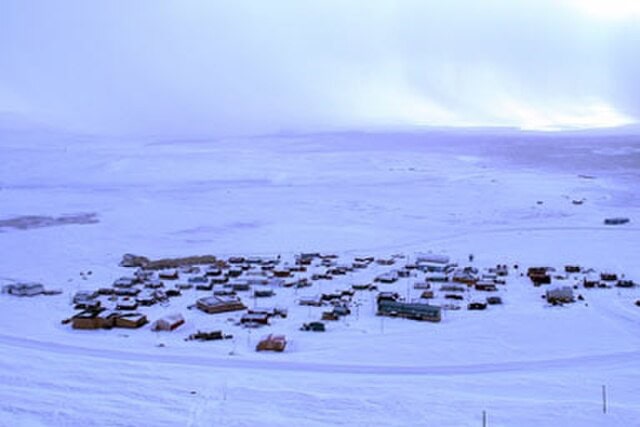
Resolute Bay is the sort of place where school can be cancelled for the day due to rampaging polar bear mobs. Its Inuit name translates to “place with no dawn”, its population is 200, and it’s located in Canada’s Nunavat district, with a storied history as a resting post for the epic northwest passage expeditions of yore. Resolute Bay looks like a setting from The Thing; it’s one the world’s coldest settlements and its polar bear, seal and beluga whale populations are correspondingly high.
In 2014, Amanda Anaviapik headed to the grocery store in the midst of a blizzard to buy some junk food. Suddenly, she heard two large heavy footprints behind her and dogs growling. She span around, only to scream with terror at the sight of colossal white polar bear. Luckily, the scream spooked the bear so much that it instantly fled; Anaviapik did likewise.
Resolute Bay is a place where almost everyone has their own story like this. Like Arviat, Inuit locals claim that polar bears are multiplying. Resolute Bay is part of the Lancaster Sound region and in 1979, polar bear numbers were estimated at 1675. In 1998, that had increased to 2457. Who knows what could have happened since?
This study has some fascinating statistics: out of the 24 Nunavat communities where self defence polar bear kills happened between 1970 and 2000, Resolute Bay had 16% of them.
In 2003 in Resolute Bay, humans and polar bears came face to face 146 times between September and November. In 142, the polar bear was scared away with deterrents like shouting, throwing rocks, cracker shells, rubber bullets or vehicles. In 28 out of 31 interactions where the cause was actually determined, the polar bears were lured in by the smell of food. Only 4 of 146 bears in Resolute were shot dead, which is still a massive total for just two or three months.
With the Lancaster Sound’s healthy polar bear population, the polar bear citadel of Resolute Bay won’t be changing any time soon.
| 8 | Franz Josef Land, Russia |
Russia’s answer to Svalbard, a polar bear-packed archipelago of 192 snowy Arctic islands, except even more remote and even less inhabited. Franz Josef land is only 560 miles away from the North Pole, closer than anywhere else in Eurasia. It’s part of the same polar bear subpopulation as Svalbard, the Barents Sea group, and they patrol most of the islands in the archipelago.
As Franz Josef Land is part of Russia’s Arctic National Park, tourist visits are almost never permitted. But when they are, guides must carry flare guns and automatic weapons at all times. Only a handful of buildings exist in Franz Josef Land, with no permanent settlements. When tourists visit, it’s perfectly common for them to climb to the top of a snowy hill, only to look around and see 5 polar bears circling them, forcing them to escape with a bright, fiery flare gun. The polar bears here are so distant from civilisation that they have no fear of humans and treat us as prey.
For us, Franz Josef Land is a bleak wasteland. For polar bears, it’s the equivalent of a tropical oasis, with arctic foxes, seals, and whales galore to feast on. The exact number of polar bears is a mystery, as Russia refuses to release the data, but bears are visibly everywhere, and healthy and fat too.
Franz Josef Land was also the site of an old Nazi base which was abandoned in 1944 after the scientists ate polar bear meat and got sick with trichinosis. Incredibly, this base was only discovered in 2016, but the polar bears have probably had the knowledge for years. Theoretically, the polar bears might have ran the Nazis out of town.
| 9 | Hall Beach, Canada |
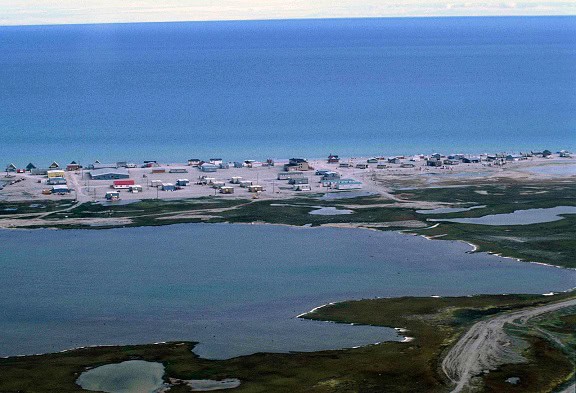
This Canadian Inuit hamlet has a beloved tradition – fermenting walrus meat on the shoreline. Consequently, they also have a tradition of being attacked by polar bears.
Hall Beach is the oldest known settlement located inside the Arctic circle, with a population of 742 and 92% Inuit. In January, the average temperature is -32C, while in July, the figure is 6C. Polar bears are a daily sighting in autumn, so much so that for local citizens, seeing a sheep would be just as amazing as a polar bear would be for an Englishman.
Once more, the Inuit locals claim that polar bears are more numerous nowadays, and statistics back them up; polar bear numbers in the Fox Basin region increased from 2300 in 1994 to 2580 in 2009-2010. There’s so many polar bears that in 2013, Hall Beach had its hunting quota stripped after shooting dead three female polar bears which strayed into the village. They lodged a court case, arguing that it was self defence and that they had no choice.
Kids are constantly having to peer round corners on their way to school in autumn; whether they find this scary or just plain fun is unclear. Historically, Hall Beach had survived independently, by hunting the plentiful walrus herds, but these days, their revenue from tourism has shot upwards, thanks to those walruses, the polar bears, and the wreckage of an old WW2 bomber on the outskirts.
As for the fermented walrus meat, traditional Inuit medicine states that so-called “igunaq” can cleanse the digestive system. Consequently, hunters often ferment the raw meat underground during the autumn, attracting the polar bears, which only get hungrier and hungrier when the meat ends up being invisible. Hall Beach’s huge amount of polar bears is directly correlated with its huge amount of walruses.
| 10 | Ryrkaypiy, far east of Russia |
Few places make more headlines for polar bear invasions than this snowy, reindeer-farming village in Russia’s far east. Ryrkaypiy is another walrus hideout, literally translating to “walrus jam”, and the polar bears have taken notice.
In 2013, two whales were washed ashore in a storm and stranded, causing 43 polar bears to arrive. Policemen put up posters in Ryrkaypiy warning people to stay indoors at night. They were even ordered to stay in groups and not to drop food litter on the streets to prevent the polar bears from detecting the scent. Like in Belushya Guba, shooting the polar bears was strictly forbidden.
In 2017, a nearby herd of walruses suffered a mysterious die off when they fell off a 38 meter cliff, and the scent of their corpses attracted 20 polar bears. The bears had their stomachs filled with blubber for days, but it didn’t dent their curiosity. The polar bears walked though the streets and one bear even tried to squeeze thorough a gap in a window.
Locals set up patrols, but 2018 saw the tradition continue. 25 bears strolled into town, and this time a lack of sea ice was to blame, trapping the bears on the coastline. Ryrkaypiy locals deployed signal rockets and rubber bullets, but the unperturbed polar bears rummaged through bins, scared old ladies and generally caused havoc.
Finally, the bears were outsmarted when locals scooped up the remains of nearby dead seals and dumped them further along the coastline. The reason why Ryrkaypiy is such a polar bear hub is its position on the annual migration route, but some would call it a cursed town.

Leave a Reply